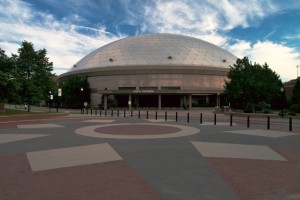Listen to the story below.
Audio Player
By Helen Stec
In July, the town of Mansfield issued a water conservation alert mandating certain measures for University of Connecticut water customers, including a ban on washing cars and limiting lawn watering to four hours per day.
This type of alert has become common over the past several years as UConn continues to grow.
“We didn’t have to issue any notices in 2008, 2009, or 2011,” said UConn Office of Environmental Policy Environmental Compliance Manager Jason Coite. “But in the past few years we’ve usually had to go to at least a request that people conserve water for a few weeks or even a few months.”
In May, the Connecticut Department of Energy & Environmental Protection granted final approval of UConn’s plan to divert 1.2 million gallons of water from Connecticut Water Company’s Shenipsit Lake Reservoir in Tolland to support the University’s growth.
What does that mean?
“In essence, it is a connection between two existing water systems in order to provide additional supply and redundancy to one of the systems,” said David Radka, director of water resources and planning for Connecticut Water.
The university currently obtains its water from groundwater wells located alongside the Willimantic and Fenton rivers.
In September 2005, a quarter mile stretch of the Fenton River went dry as a result of the University’s water consumption. Since this incident, UConn has tightened restrictions on its well fields and enforced strict conservation efforts.
“What we’ve done in recent years is created some operating rules that limit how much water we can pull out of the Fenton River when streams get really dry,” Coite said.
According to the UConn Office of Environmental Protection, in 2014, the University’s water consumption was 465,478,000 gallons. That’s almost 84,000,000 gallons, or 15.5%, less than the 542,351,000 gallons consumed in 2005.

As the student population at UConn continues to grow, it creates the need for more water from outside sources. (Image Credit: Matthias Rosenkranz / Creative Commons)
UConn is using less water even though the user population has grown by 23% since the year the Fenton was pumped dry. According to the OEP, UConn is on track to save an additional 100,000 gallons of water per day this year.
Still, DEEP determined that the new pipeline’s water was necessary to supplement UConn’s water supply and support long-term growth on campus as well as in the Storrs area of Mansfield.
Before deciding to build the pipeline, an Environmental Impact Evaluation examined water supply alternatives. According to Radka, five different options were studied.
“Based on an exhaustive analysis done by an independent consultant, which looked at the various environmental impacts, this was deemed to be the least environmentally impactful of all those alternatives,” he said.
Coite said environmental sustainability was foremost on the University’s mind.
“So while we’ve got this growth on the horizon, and we need the pipeline to support that growth, it’s going to be responsible growth. It’s going to be done wisely and certainly with a lean towards sustainability,” said Coite.
However, not everyone agrees. In an editorial for the Hartford Courant in April, UConn geology professor Robert Thorson wrote that he’s not okay with, “teaching environmental sustainability while supporting unsustainable growth.”
In the article, he voiced his concern that many of UConn and Mansfield’s new projects, including the construction of the new pipeline and what he refers to as the University’s draining of natural watersheds in Tolland, Ellington, and Vernon, seem to prioritize economic development over environmental protection.
Coite disagrees. He said the pipeline won’t have much of an impact on Tolland, where water is being diverted from the Shenipsit Lake Reservoir.
“The impacts will be either nonexistent or imperceptible, and we made the case to the Department of Energy and Environmental Protection, had a public hearing process, and, basically, DEEP concurred that the impacts are certainly within the acceptable range,” said Coite. “It would still be protective of the environment, even with the diversion going to UConn.”
Construction of the pipeline is expected to be completed in Fall 2016.


